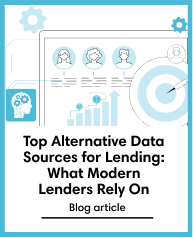Alternative Data
Jan 5, 2022
Modern borrower behaviour in volatile times
Subscribe to our newsletter
The emergence of alternative data represents a new opportunity for many of today’s traditional credit bureaux. Alternative data, for instance, can be used to include and accurately assess thin-file customers and the millions unbanked all over the world. With alternative data, traditional credit bureaux can put together a more accurate credit score and reduce revenue uncertainty, loan defaults, and poor planning and forecast provisions.
Yet with non-performing loans (NPLs) rising and furloughs, moratoriums, and payment holidays increasingly offered by regulatory bodies as the world recovers from the COVID-19 pandemic, lenders must understand the context alternative data will be used in. Lenders must know how recent developments will shape borrower behaviour.
Reopenings will mean increased demand for credit
Research from independent think-tank Consultative Group to Assist the Poor (CGAP) anticipates that many people will turn to credit and loans as an anchor while global economies reopen. Many borrowers will have depleted their savings during lockdowns, with borrowing the only way for them to restart a business or continue paying bills.
Yet desire-based borrowing is also set to rise. According to a survey from Home Credit India, small loans or credit for consumer durables purchases accounted for 26% of the total borrowings in the country.
Tight credit standards could result in a credit crunch for lower-income borrowers as demand grows again. Responsible underwriting will have to look different from pre-pandemic standards. Lenders should prepare for a deluge of borrowers.
Stressed borrowers meet lenders under pressure
Financial service providers must juggle high arrears and loss of income and liquidity because of loan moratoria to borrowers, withdrawals from accounts, and inability to operate branches. Unfortunately for borrowers, CGAP’s Pulse Survey shows that many lenders are responding to the challenge by cutting lending by more than half and a small fraction stopping altogether. There are already reports of loans becoming less available in the United States and in the Philippines.
Many lenders may not be capable of meeting the increasing demand. Though policymakers helped some institutions through liquidity facilities and relaxed reserve or provisioning requirements, this does little to benefit the many lower-income people who often turn to non-regulated and cooperative institutions instead.
The onus is onto institutions to adjust
The evolution of digital credit scoring is something lenders cannot ignore. It’s suggested that credit providers recalibrate internal scoring models to keep up with innovations in fintech credit scoring such as credit scoring apps that use alternative data/alternative credit scoring to provide a more accurate, real-time credit score.
By harnessing the power of alternative data and new developments in fintech credit scoring, lenders can better service the borrowers driving up the demand for loans in the coming future. If a borrower cannot provide a banking history, lenders can look at their smartphone data usage or bills payment history—all examples of alternative data. Borrowers can better scrutinise who is likely to default on loans and increase their confidence to lend more without worrying about becoming another NPL statistic.
Fintech companies have grown to help lenders. One fintech company helping improve credit risk management is credolab, which offers a credit scoring SDK (software development kit) that can be easily implemented into a lender’s pre-existing scoring model. The credit scoring capabilities of SDK boosts accurate real-time underwriting, adding digital behaviour insights to the mix. In another demonstration of fintech credit scoring, the fintech company’s fraud SDK even generates fraud scores to identify the best potential loanees.
The next few months will mean a noticeable uptick in loan applicants. They will be people hoping to get back on their feet after suffering the repercussions of the COVID-19 pandemic. With alternative data and quickly evolving technology, there’s no reason lenders shouldn’t be able to give borrowers what they need.





